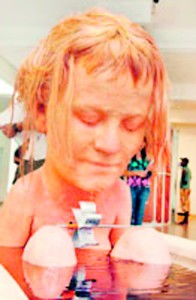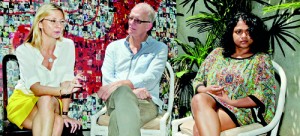They’ve thrown out the bath water but kept the blonde babe
By any measure, the Colombo Art Biennale 2014 will be a sprawling, mind-staggering affair, bigger and more action-packed than the last outing, in 2012, which itself was an overwhelming showcase of international and local contemporary art.
CAB14 will carry a lot more to see and experience – more artists, participants and events – and it is altogether more ambitious in scope, says CAB founder and chief curator Annoushka Hempel. Exploratory, adventurous, provocative, and Very Now – that’s what Biennales are about. That was how the 2010 and 2012 shows were presented; add to that and multiply some and you get a sense of Edition 2014.

The weeping blonde in a bathtub attracted much attention at the last Colombo Art Biennale, in 2012. Pic by Indika Handuwela
The scale and logistics of “Making History”, as CAB14 is themed, are daunting, but Hempel and her team, which includes co-directors Neil Butler and Ruhanie Perera, are confident. And all smiles. The 10-day contemporary art tour takes off in 10 days’ time (starting January 31). Hempel & Co have been test-running their vehicle for weeks and their verdict is “very roadworthy.”
The artists will hail from all points of the compass, while the CAB14 itinerary roadmap highlights, among dozens of stops, Central Point (Economic History Museum), in Chatham Street, Fort; the Postgraduate Institute of Archaeology, Bauddhaloka Mawatha; the Lakshman Kadirgamar Institute for International Relations, Horton Place, as well as the J. D. A. Perera Gallery, the Park Street Mews, Goethe-Institut and Barefoot Gallery. As with the two previous shows, viewers will be very physically involved as they crisscross the city in pursuit of art.
Annoushka Hempel’s intense workday is one art encounter after another. She was at a young artist’s debut at the nearby J.D.A. Gallery and is 10 minutes late for our meeting, scheduled at her Barnes Place home. We were in this same house two years ago, on February 19, 2012, the last day of CAB12. Hempel’s home, also known as Hempel Gallery, was one of the stops in the 2012 itinerary. We didn’t see the Hempels, but we saw a lot of art. It was all over the house. The Hempel home is an open invitation to art production, participation and enjoyment.
So where will CAB14 be taking us art-agog passengers?
“This will be a much bigger event than the last two outings,” Hempel says. “The first Colombo Biennale, in 2009, was an experiment, to see how a big contemporary art happening would be received. We were also encouraging local artists to think and work outside gallery and commercial demands, and now they do.” At one time, Hempel says, the best work of local artists was what she found in the artists’ homes and their tiny sitting-room-dining-room-bedroom studios.
Big players have come on board.
“Google has joined the Colombo Biennale. They will be giving us their support right through the show. And we also have the support of the Sovereign Foundation in Hong Kong and the Dhaka Art Summit.”
What is new about CAB14?

A collaborative effort: Colombo Biennale founder and chief curator Annoushka Hempel, left and co-curators Neil Butler and Ruhanie Perera.
“There will be new media art, such as video art, sound art. And there will be, for the first time in the Colombo Biennale, a focus on live art to encourage further interaction with the public. How this will be done you will have to come and see.”
Hempel believes that art is good for everyone, not just the artists alone and those who support them.
“It’s a phenomenal opportunity for the business community and the community in general,” says Hempel. “The arts are a major asset to the country. There are big benefits that can be achieved through supporting this arena. It’s no stretch to say the arts can help an economy.”
The message here is that doing something big and international, and doing it well, is its own recommendation.
The last Biennale, CAB12, titled “Becoming”, is recent history, and it made history here and beyond our shores. It seems like the other day when we were racing around town, that Sunday, February 19, in 2012, desperately cramming into one manic last-minute art tour what others had taken five days to experience and ingest. We were determined to visit every venue and take in as much as time permitted.
Our starting point was the Colombo Art Gallery. Its two main exhibition halls had been transformed into a new kind of art-accommodation, the cavernous white spaces looking like interiors out of Art Forum or Hi-Fructose. Everything cutting-edge and way out; art on the walls, on the floors, scattered and littered at every turn.
When we arrived, one of the main exhibits – an inflated, oversized contrivance painted over in gold and installed by an Indian artist – had been dismantled after technical problems occurred, said a CAB12 volunteer, who was showing us around. The space feels a bit empty now, he said. For us, it was full enough. Local and foreign artists had taken up positions to tell stories, achingly true or fabulously stylised. The images and image sequences ranged from wistful (like the work of Menika van der Poorten and Dominic Sansoni) to outrageous, like the blown-up photograph showing a scantily clad (or was she naked?) woman playing at a grand piano suspended by ropes over the edge of a cliff. That image, from an outdoors art performance in Europe, set the outré tone of CAB12 for this viewer.
The other hall, or half, of the gallery was dominated by an ominously clicking, ticking, blinking apparatus built around a revolving wooden drum that was generating electricity and causing strips of red and white light bulbs to flash across the floor. It was like a warning to the viewer to tread cautiously because art can be risky, and contemporary art can be dangerous. Exhibits using gilded barbed wire abounded.
Mind teeming with astringent colours and over-the-top concepts, we next headed to the J. D. A. Gallery, in Horton Place, where things were no less sharp, wild and daring. Out of the dozens of unpredictable objets d’art – framed art and loud-and-soft installations spread over three levels of exhibition space – there was one set-up that seemed to attract more attention than the others: in a far corner sat a blonde in an old-fashioned bathtub, her back to the viewer. You felt compelled to approach on tiptoe. A plip-plop of dripping water was the only sound. The celluloid lady with an outsize head, sitting chest-deep in opaque bathwater, was shedding large tears – the falling drops activating a metal bar, the mechanism behind the cycle of her endless weeping, her inscrutable sadness. This eerie, melancholy prop is always the first image to pop up in the memory whenever CAB12 comes up in conversation or on the Net.
Another bathtub, in a creepy context, turned up on a different floor. This was in a film running continuously inside an “adults-only” video-screening booth. We peeped inside. Footage showed a huge, hairy-chested male sweating in a bathtub and stuffing his face with pasta; we withdrew when the man started to haemorrhage and the bathwater turned red. Contemporary art can be scary; it has no obligation to be pleasant or palatable.
Mention must be made of an exhibit that was literally “cutting-edge”: a sleek set of pinewood chairs arranged round a table: if you weren’t looking closely, you would have sat on a grid of raised razor blades, lined and patterned to form the seat of the chairs. Contemporary art can be sly, cynical, subversive.
But, for relief, there was work that pleased and charmed, like Pradeep Thalawatte’s long rectangular frieze of bone-white trees etched against a sky of a heavenly artificial hue. Video footage next to the mural showed the artist while he was working on the project, magically scratching arboreal shapes into the surface skin of blue paint. It was a sublimely cool piece of art, and we kept returning to it, as if to soothe eye and mind.
Our CAB12 cruising next took us to the Park Street Mews. It was already getting dark. We felt a bit dizzy. Colombo and its houses and streets were beginning to look a little different, fractionally askew and oddly tinted. All this accumulating art was beginning to have a heady effect on our perceptions. At the mews, one of the two converted stables contained a multiplex of black-curtained cells screening experimental video films; the other housed more installations, including a cascade of strung-up firecrackers that would have blown the roof off if a myopic cigarette-smoker had walked into it.
We were running out of time. And energy. We grabbed an iced Heineken and raced to our next and final stop, a warehouse-turned-arthouse in Maradana, opposite the Elphinstone Theatre. It was late and everyone there, volunteers and artists, looked exhausted and ready to pack up and go home. We didn’t stay long, but long enough to take in the main attractions – a suite of furniture made for giants comprising towering chairs and tables; suspended wire cages for dancing couples who want to be different; mirror rooms to see how others see you, and a wistful Made-In-China installation. There was a lot more, but you can take in only so much in a day. We were at dropping-off point.
On our way out, we noticed a so-so installation set up near the exit – normal-size chairs, legs in the air, stacked to the ceiling. What’s so original about that, we wondered, only to go back and ascertain that the chairs were no installation; they were there for a Biennale closing party. We laughed as we hopped into the waiting three-wheeler. Exhaustion, an excess of art, sensory overload, and possibly the beer, were turning the world upside down, and everyday objects were morphing into one “artwork” after another. If one of the main reasons for calling on art is to ask it to take us out of ourselves, and for a spell to modify our perceptions of the world around us, then CAB12 had succeeded superbly.
As we crested the Maradana junction and saw the city lights in the distance and around us, we thought Colombo looked exceptionally beautiful. An urban fairyland. Colombo looked different that night. And then we knew why. For the first time, we were seeing the city for what it really is: one happy, winking, gigantic installation.


